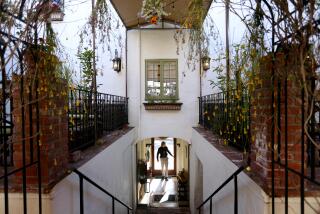Environmentalist Accused of Interest Conflict in De Anza Proposal
- Share via
San Diego City Councilman Bruce Henderson on Thursday accused one of the city’s leading environmentalists of secretly soliciting hundreds of thousands of dollars in payments to help a developer win city approval for a 1,400-room hotel and resort on the shores of Mission Bay.
Minutes after Henderson’s press conference, Mayor Maureen O’Connor took her place before television cameras in the same City Hall conference room, expressed “shock,” and said that Bob Glaser, co-chairman of San Diegans for Managed Growth, should resign if Henderson’s charges are true.
Glaser vehemently denied the accusations, contending that he had suggested that the developer, the De Anza Group Inc., locate the proposed hotel east of Interstate 5 and utilize 70 acres of De Anza Point as parkland instead.
Glaser said that De Anza rejected his written offer, made in August, to act as a consultant and develop the idea for a fee that would escalate as work progressed. He said the firm is intent on building along Mission Bay, where it holds the lease to the De Anza Point parcel and the nearby 50-acre Campland on the Bay campground.
Michael Gelfand, senior vice president of the Beverly Hills-based De Anza Group, was unavailable for comment Thursday.
Don Wood, president of Citizens Coordinate for Century 3, a leading San Diego environmental organization, confirmed Glaser’s version, saying that the environmentalist had never discussed a proposal to allow the resort to be situated on the bay.
Glaser “was trying to come up with a workable solution for all parties that was environmentally sensitive, and it sounds to me like it was intentionally misinterpreted (by Henderson) for political purposes to try to damage him,” Wood said.
The daylong exchange of accusations is steeped in a political controversy that was stirred up earlier this month, when the newly seated City Council ousted Henderson as chairman of the council’s Public Facilities and Recreation committee, which oversees the city’s parkland and will next month review a scaled-down De Anza resort proposal.
Glaser was one of a group of environmentalists who signed a memo to O’Connor urging Henderson’s ouster and his replacement with Councilman Bob Filner, a favorite of environmentalists.
Henderson was publicly neutral on the De Anza project, which is in his council district, until Nov. 16, when he announced his opposition to it. In September, the council went on record against proposed state legislation that would have extended De Anza’s lease on the tidelands from 2003 to 2053. State Sen. William Craven subsequently withdrew the bill.
Henderson’s critics have said that his stand was prompted by results of the city’s new district elections system, in which three candidates backed by environmentalists defeated three pro-growth candidates.
Glaser, who ran against Henderson in 1987 and lost in the primary, is considered a possible opponent in the 1991 election.
Henderson charged that it was hypocritical for Glaser to work for his ouster from a council committee while he was soliciting business from De Anza. “There must be a full disclosure of private motivation by those who claim to lead this highly principled movement,” he said.
Decrying the “parasites of the environmental movement” and accusing Glaser of “greenmail,” Henderson produced a three-page draft contract between Glaser’s La Jolla Group consulting firm and De Anza that bears Glaser’s signature. Henderson called the document a “smoking gun.”
Dated August, 1989, the contract has an empty space for Gelfand’s signature. It asks De Anza for $2,500 for presentation of the proposal, $25,000 for use of Glaser’s plan, $250,000 if the city approves the plan and $125,000 per city precinct for community organizing and public education about the project. (Glaser claims that the sum is a typographical error; the contract should have listed $125 per precinct, he said.)
Dubbing the plan, the “Mission Bay De Anza Expansion Project,” Glaser offers in the contract to “maintain the largest number of hotel rooms possible,” increase its “economic viability” and resolve the “Campland issues” and relocation of 1,000 mobile home residents now living at the De Anza Harbor Resort trailer park “at lowest relocation cost to De Anza.”
Henderson noted that, in June, San Diegans for Managed Growth and the Sierra Club quietly tried to settle a lawsuit that sought to protect a parcel of land near Scripps Ranch for a $500,000 payment from the developer. That move, which was scuttled when it was publicly revealed, brought a scathing letter from O’Connor, who accused the environmental groups of selling out their ideals.
O’Connor also went on the offensive against Glaser on Thursday, but made it clear that she had no independent knowledge of the situation and was seeing Henderson’s documents for the first time.
Glaser said he proposed locating the hotel east of I-5, in the city’s Morena district, using the Mission Bay acreage for parkland instead. The land swap would allow De Anza to build a bigger hotel and a tram or shuttle would take hotel occupants to the beach.
“Hell, I saw a way to make some money, protect the bay and solve everybody’s problem,” he said.
More to Read
Sign up for Essential California
The most important California stories and recommendations in your inbox every morning.
You may occasionally receive promotional content from the Los Angeles Times.













